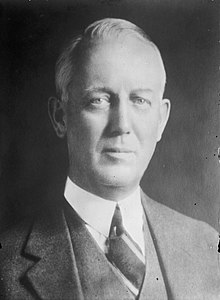
Summary
Frank Leslie Smith (November 24, 1867 – August 30, 1950) was an Illinois politician.
Frank Smith | |
|---|---|
 | |
| United States Senator-elect from Illinois | |
| In office Not seated | |
| Preceded by | William B. McKinley |
| Succeeded by | Otis F. Glenn |
| Member of the U.S. House of Representatives from Illinois's 17th district | |
| In office March 4, 1919 – March 3, 1921 | |
| Preceded by | John Allen Sterling |
| Succeeded by | Frank H. Funk |
| Personal details | |
| Born | Frank Leslie Smith November 24, 1867 Dwight, Illinois, U.S. |
| Died | August 30, 1950 (aged 82) Dwight, Illinois, U.S. |
| Political party | Republican |
Biography edit
Smith was born in Dwight, Illinois on November 24, 1867. He was raised and educated in Dwight, then taught school for several years. Smith then embarked on a business career, and his interests included farming, banking, and real estate. Smith served in local office, including Dwight's village clerk in 1894. In 1904, he was an unsuccessful Republican candidate for lieutenant governor. From 1905 to 1906, he was a federal internal revenue collector for the district that included Dwight. In 1918, he was a successful candidate for the United States House of Representatives, and he served one term, March 4, 1919 to March 3, 1921.
Career edit
Smith first ran for the Republican primary nomination for the U.S. Senate in 1920. In that first year of suffrage, women's votes were counted separately from men's in Illinois. He was beating William B. McKinley by 27,000 votes after the male votes were counted, but once the female votes were counted, McKinley had won by 11,000 votes. McKinley went on to win the general election as well. In 1921, Smith became the chairman of the Illinois Commerce Commission, which oversaw utilities in the state.
In 1926, Smith defeated McKinley in the Republican primary for the Senate. Smith went on to win the general election held in November, although Julius Rosenwald of Sears, Roebuck & Company had offered him $550,000 in stock to withdraw.[1][2] Senate investigators subsequently accused Smith of exceeding allowable limits by spending more than $400,000 on his campaign, including $125,000 from utilities that had business before the commerce commission while Smith was a member.[3]
McKinley's term was due to expire in March 1927. He died in December 1926, and Illinois Governor Len Small (R) appointed Smith to fill the vacancy. When Smith presented his credentials, the U.S. Senate voted not to seat him, based upon the alleged fraud and corruption. In March 1927, he again attempted to qualify, based on the results of the November 1926 election, but the senate again declined to seat him. After the seat had been vacant for more than two years, Smith resigned on February 9, 1928.[4][5][6]
See also edit
- Frank L. Smith Bank
- Frank L. Smith | Society for American Baseball Research Biography
- Unseated members of the United States Congress
References edit
- ^ Ascoli, P. M. (2016). Julius Rosenwald the man who built Sears, Roebuck and advanced the cause of black education in the American South. Bloomington: Indiana University Press.
- ^ "Gov. Lennington Small". nga.org.
- ^ "The (Other) Man Who Tried to Buy a Senate Seat". nbcchicago.com. June 3, 2011.
- ^ Frank Lloyd Wright Library Archived September 17, 2018, at the Wayback Machine, Frank L. Smith photographs, US Senate campaign brochure, accessed September 16, 2017
- ^ Senate Historical Office, United States Senate. "The Election Case of Frank L. Smith of Illinois (1928)". senate.gov.
- ^ "Congressional Record - Senate" (PDF). govinfo.gov. January 19, 1927. pp. 1911–1982.
- "Frank L. Smith, 82, Lost Senate Seat," New York Times, August 31, 1950, p 22.
- Carroll Hill Wooddy, The Case of Frank L. Smith: A Study in Representative Government, University of Chicago, Chicago, IL, 1931.
External links edit
- Media related to Frank Leslie Smith at Wikimedia Commons
- United States Congress. "Frank L. Smith (id: S000534)". Biographical Directory of the United States Congress.


